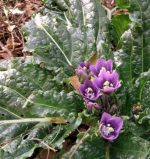 Also called love-apple, mandrake ( דודאים dudaim in Hebrew) is a very variable herbaceous perennial that is native to the Mediterranean area including Israel and the Levant and some soucses would classsify mandrakes in the eastern Mediterranean as M. autumnalis. It is a member of the nightshade family, Solonaceae, that also includes potato, tomato, and eggplant. The plants have a short stem bearing a rosette of ovate leaves and a thick forked root that is highly toxic and resembles the lower half of a human body. The leaves are up to 18″ long and vary in hairiness. In spring, bell shaped flowers with 5 speals and 5 greenish white to pale blue or violet petals appear in the leaf axils on stalks up to 18″ long. Yellow to orange egg-shaped berries up to 1.6″ wide appear from late autumn to early summer and contain numerous light brown seeds. Photo Credit Wikipedia
Also called love-apple, mandrake ( דודאים dudaim in Hebrew) is a very variable herbaceous perennial that is native to the Mediterranean area including Israel and the Levant and some soucses would classsify mandrakes in the eastern Mediterranean as M. autumnalis. It is a member of the nightshade family, Solonaceae, that also includes potato, tomato, and eggplant. The plants have a short stem bearing a rosette of ovate leaves and a thick forked root that is highly toxic and resembles the lower half of a human body. The leaves are up to 18″ long and vary in hairiness. In spring, bell shaped flowers with 5 speals and 5 greenish white to pale blue or violet petals appear in the leaf axils on stalks up to 18″ long. Yellow to orange egg-shaped berries up to 1.6″ wide appear from late autumn to early summer and contain numerous light brown seeds. Photo Credit Wikipedia
The hallucinogent and narcotic properties of mandrake and the resemblance of its root to the human form have led to a long association with superstition, witchcraft, and magic as well as medicine.
Genesis 30 NIL The ancients believed that the mandrake had the power of making barren women fertile so scholars believe that Rachel, the childress wife of Jacob, wanted the mandrake in order to induce fertility.
14.”During wheat harvest, Reuben went out into the fields and found some mandrake plants, which he brought to his mother Leah. Rachel said to Leah, “Please give me some of your son’s mandrakes.”
15. “But she [Leah] said to her [Rachel], “Wasn’t it enough that you took away my husband? Will you take my son’s mandrakes too?” “Very well,” Rachel said, “he can sleep with you tonight in return for your son’s mandrakes.”
16. “So when Jacob came in from the fields that evening, Leah went out to meet him. “You must sleep with me,” she said. “I have hired you with my son’s mandrakes.” So he slept with her that night.”
Songs of Songs 7.13 NIV The bride gives her love to the bridgroom.
“The mandrakes give forth fragrance. At our doors are all kinds of precious fruits, new and old, which I have stored up for you, my beloved.”
Mandrakes like full sun but tolerate some shade, and average, light, medium moist, well-drained soil in USDA Hardiness zones 6-9. They grow best in areas where summers are hot and moisture comes in the winter but are suscetible to damage by slugs and snails. Propagation is by seed or cuttings in winter.
The genus name, Mandragora, is the classical Latin name for the plant. The specific epithet, officinarum, is the classical Latin word meaning of workshops and refers to the real or supposed medicinal properties.